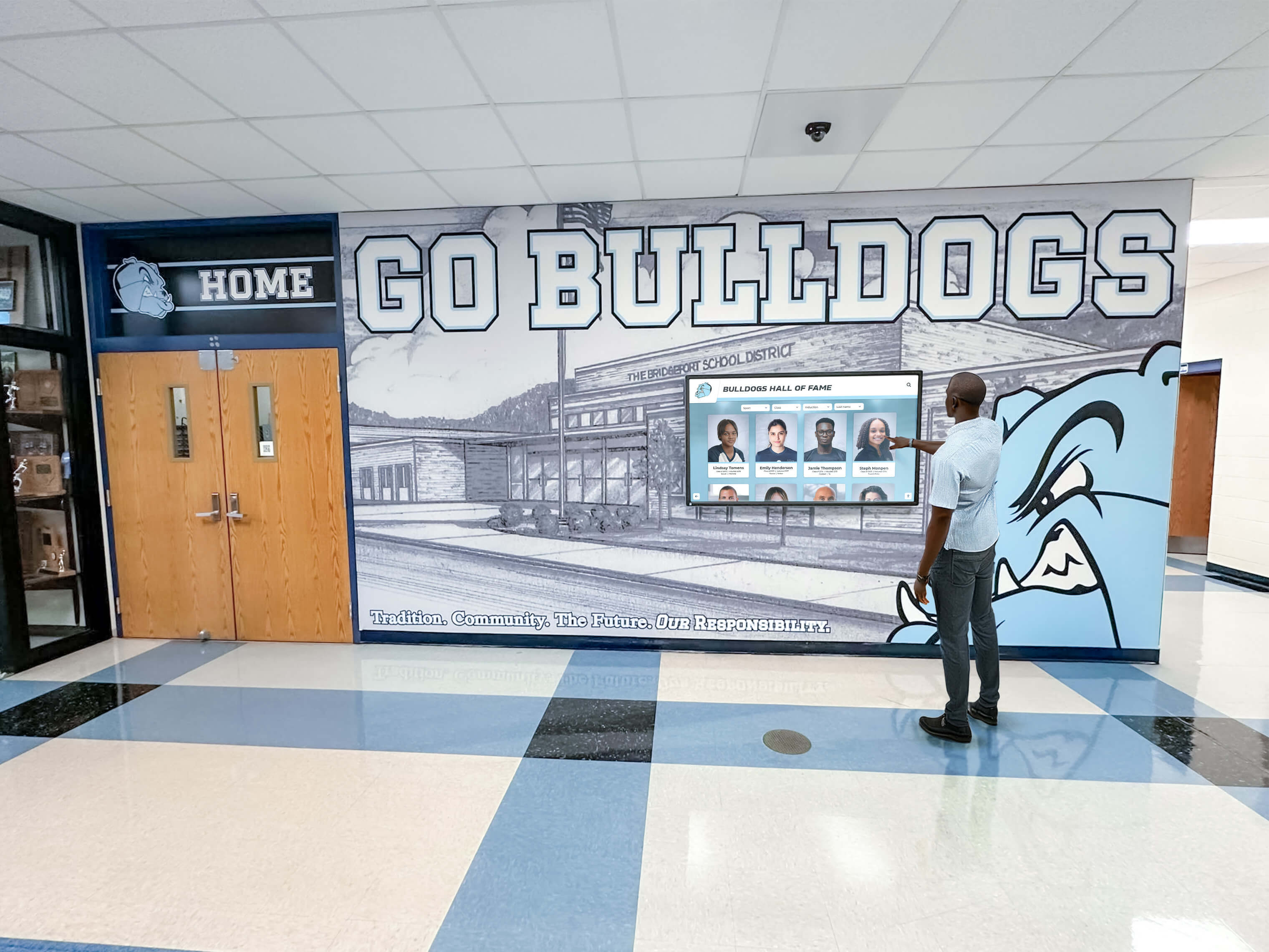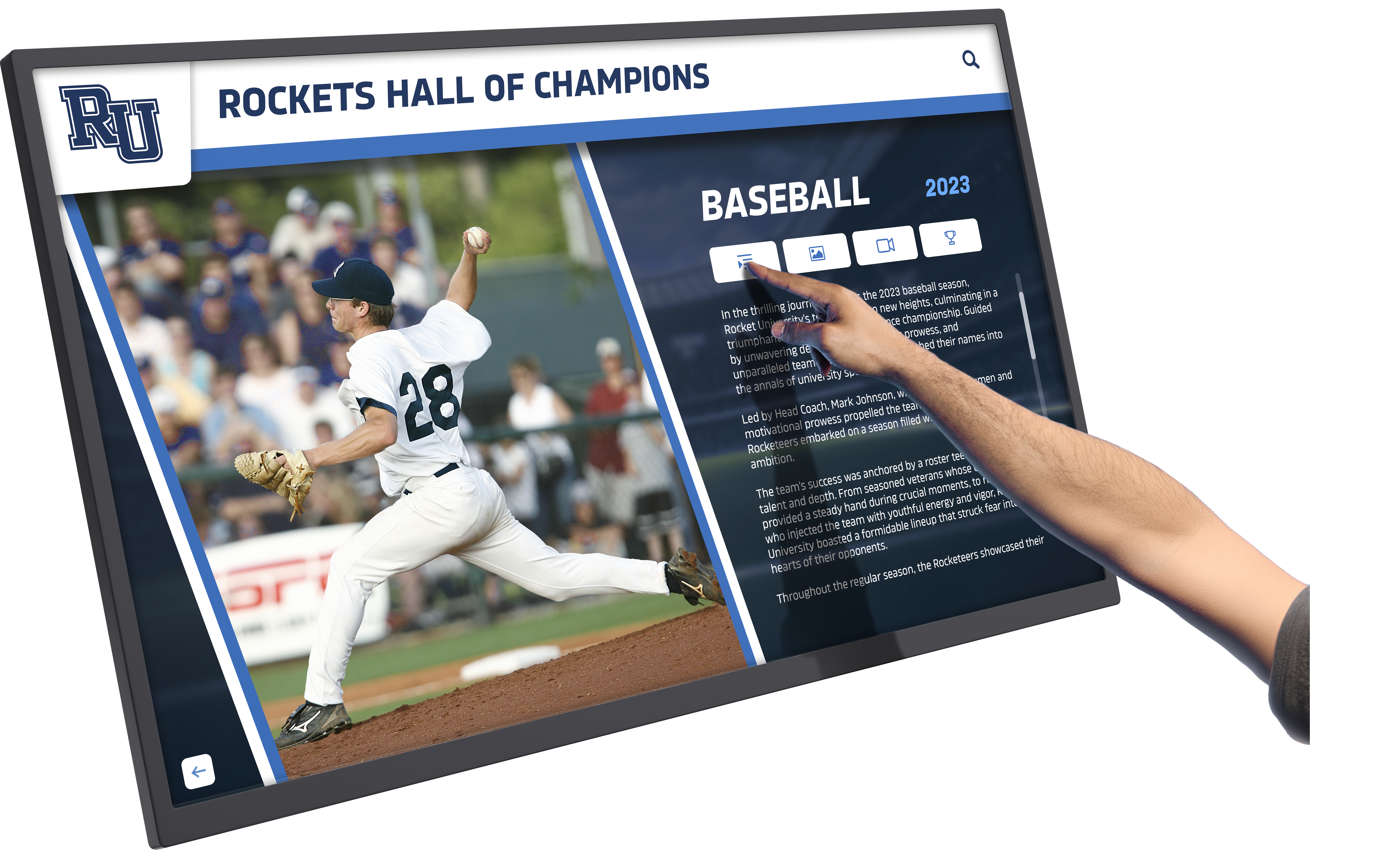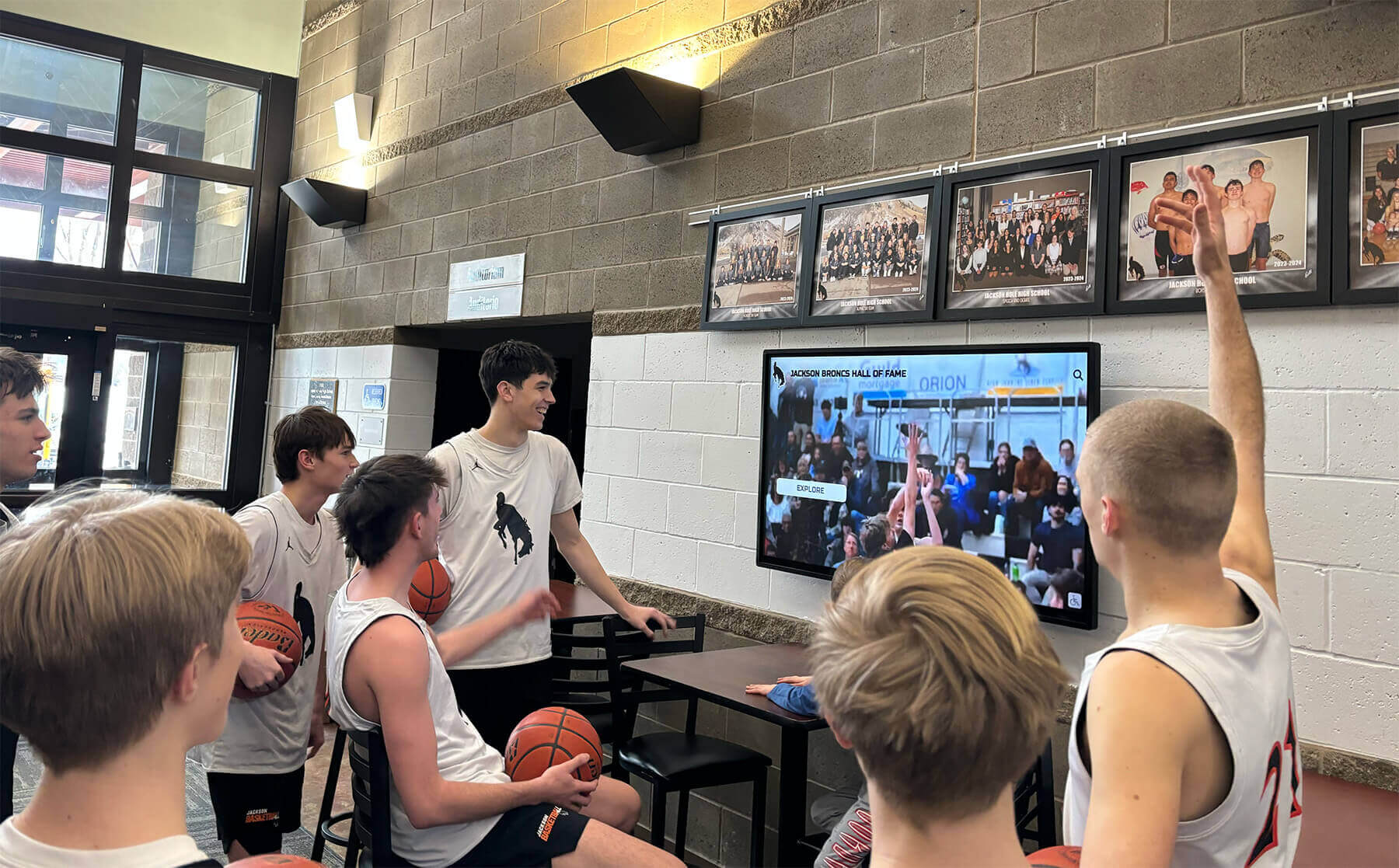Key Takeaways
Comprehensive guide to creating interactive displays celebrating junior varsity basketball teams. Learn how digital recognition solutions showcase JV accomplishments, build team culture, and inspire player development across your basketball program.
The Critical Importance of Junior Varsity Basketball Recognition
Understanding why JV basketball recognition matters helps athletic programs design comprehensive acknowledgment systems that strengthen team culture, support player development, and build sustainable program excellence.
The Essential Role of JV Basketball in Program Success
Junior varsity basketball serves multiple critical functions that directly impact overall program quality and competitive success:
Player Development Pipeline:
JV teams provide structured environments where younger athletes develop fundamental skills, learn offensive and defensive systems, adjust to competitive game speed, and build the physical and mental toughness required for varsity competition. Programs that invest in quality JV experiences create deeper talent pools while accelerating individual player development through meaningful competitive opportunities that freshman-only teams or practice-only roles cannot match.
Program Culture Foundation:
The culture established within JV programs—work ethic expectations, team-first attitudes, practice intensity standards, and accountability norms—shapes athletes who eventually become varsity contributors and team leaders. When JV programs emphasize positive culture alongside skill development, they produce not just better players but better teammates who understand program values and model behaviors that sustain excellence across seasons.

Competitive Experience Accumulation:
Game experience against comparable competition provides irreplaceable learning opportunities that practice alone cannot deliver. JV players develop decision-making skills under pressure, learn to manage game emotions, experience both victory and defeat, and build confidence through meaningful contributions in competitive situations. This experience foundation prepares athletes for eventual varsity roles while ensuring they don’t face that transition without competitive background.
Team Depth and Flexibility:
Strong JV programs create roster depth enabling varsity coaches to manage player workloads, provide rest without competitive sacrifice, recover from injuries without catastrophic impact, and maintain practice quality through genuine competition for playing time. Programs that develop multiple players at each position through quality JV experiences demonstrate consistent success rather than occasional excellence dependent on exceptional individual talents.
Why Traditional Recognition Approaches Fail JV Athletes
Despite junior varsity basketball’s program importance, traditional recognition methods typically undervalue JV contributions:
Space-Constrained Physical Displays:
Trophy cases and wall plaques occupy limited facility space that athletic programs typically dedicate primarily to varsity accomplishments—championship trophies, varsity record boards, and varsity all-conference recognition. Physical space constraints force difficult prioritization decisions that almost invariably favor varsity over JV recognition, leaving developing athletes with minimal visible acknowledgment despite significant contributions.
Resource Allocation Patterns:
Budget limitations lead many programs to invest recognition resources almost exclusively in varsity accomplishments. The recurring costs associated with traditional plaques—production expenses, installation fees, and space requirements—make comprehensive JV recognition economically challenging when combined with varsity recognition needs and other athletic program demands.
Visibility and Prominence Disparities:
Even when programs attempt JV recognition through traditional methods, these acknowledgments typically appear in secondary locations with reduced visibility compared to prominent varsity displays. Relegating JV recognition to lesser spaces inadvertently communicates that JV accomplishments matter less than varsity achievements, undermining intended recognition messages.
Solutions like digital record boards eliminate these traditional constraints by providing unlimited capacity for comprehensive recognition across all program levels without the space limitations and recurring costs that restrict traditional approaches.
The Unique Recognition Needs of Junior Varsity Basketball
JV basketball recognition requires thoughtful approaches addressing the specific developmental stage and competitive context these athletes occupy within broader basketball programs.
Age-Appropriate Recognition Approaches
Junior varsity players, typically freshmen and sophomores, exist at developmental stages requiring recognition approaches acknowledging their growing maturity:
Emphasis on Growth and Improvement:
JV recognition should prominently celebrate improvement trajectories alongside absolute performance levels. Recognizing players who demonstrate significant skill development, statistical improvement from season start to finish, increased confidence and assertiveness, or enhanced basketball IQ emphasizes that development matters as much as current capability—crucial messaging for athletes still building toward full potential.
Skill Development Milestones:
Beyond game statistics, JV recognition can acknowledge specific skill acquisitions meaningful at this developmental stage—first successful three-pointer in competition, defensive stance consistency, free throw accuracy improvements, or assist-to-turnover ratio enhancements. These granular recognitions demonstrate that programs notice individual progress while providing concrete goals motivating continued development.
Character and Attitude Recognition:
JV teams include players at various points along maturity spectrums. Recognition that acknowledges exemplary practice attitudes, positive teammate support, coachability demonstrations, and leadership emergence reinforces that basketball programs value character development alongside athletic skill, creating comprehensive player development environments.

Balancing Individual and Team Recognition
Effective JV recognition balances personal acknowledgment with team accomplishment celebration:
Complete Roster Recognition:
Unlike varsity levels where recognition often concentrates on starters and stars, JV programs benefit from recognizing all roster members who contribute to team success. Digital displays enable comprehensive team rosters showing every player, acknowledging participation regardless of playing time, and celebrating collective achievements that require contributions from entire squads.
Role Player Acknowledgment:
JV teams include players fulfilling various roles—practice leaders who push starters, defensive specialists who accept limited offensive opportunities, or bench players who stay engaged supporting teammates. Recognition systems that acknowledge diverse contribution types demonstrate that programs value all roles rather than only statistical achievements, strengthening team culture and player commitment.
Team Statistical Achievements:
Beyond individual accomplishments, JV team statistics—win-loss records, offensive efficiency, defensive statistics, or improvement throughout seasons—provide recognition opportunities celebrating collective success. Team-level recognition ensures all contributors receive acknowledgment for shared accomplishments while emphasizing basketball’s collaborative nature.
Connecting JV Recognition to Varsity Pathways
Strategic JV recognition creates visible connections between current JV participation and future varsity success:
Highlighting Progression Examples:
Showcasing current varsity players’ JV backgrounds demonstrates clear developmental pathways. When JV athletes see that successful upperclassmen followed similar journeys, it reinforces that current JV participation represents meaningful steps toward varsity roles rather than endpoints. Interactive displays can link JV and varsity profiles, showing progression through programs.
Multi-Year Player Tracking:
Following individual athletes across seasons—freshman JV statistics, sophomore JV or varsity contributions, junior varsity roles—creates narrative arcs showing development trajectories. These multi-year perspectives help younger athletes visualize their potential pathways while demonstrating that basketball development requires time and continued effort.
Recognition approaches like comprehensive athletic displays demonstrate how institutions can effectively acknowledge athletes at all program levels, creating inclusive recognition environments supporting development across multiple seasons.
Interactive Digital Solutions for JV Basketball Recognition
Modern digital display technology provides ideal platforms for comprehensive junior varsity basketball recognition, offering capabilities far exceeding traditional static displays.
Unlimited Recognition Capacity
Digital recognition systems eliminate space constraints that force traditional displays to prioritize limited accomplishments:
Complete Team Documentation:
Interactive displays accommodate full team rosters across multiple years without capacity limitations. Every JV player from program history receives equal digital space for photos, statistics, biographical information, and achievement recognition—comprehensive acknowledgment impossible with space-constrained trophy cases.
Multi-Year Historical Archives:
Digital platforms preserve JV team history indefinitely, enabling current athletes to explore previous seasons, compare performances across years, and understand program development patterns. Historical depth creates institutional memory celebrating junior varsity contributions across decades rather than only recent seasons.
Detailed Individual Profiles:
Unlike plaques limited to names, years, and perhaps single statistics, digital profiles can include comprehensive player information—season and career statistics, position details, jersey numbers, memorable game performances, quotes from coaches, and post-season honors. Rich profiles provide meaningful recognition far exceeding traditional plaque capabilities.

Engaging Interactive Features
Digital displays create interactive experiences that resonate with tech-savvy student-athletes:
Search and Discovery Capabilities:
Players, families, and community members can search athlete names, browse by season or team, filter by statistical categories, and explore connections between JV and varsity careers. Interactive navigation transforms passive viewing into engaging exploration where users discover personally relevant content.
Multimedia Content Integration:
Digital platforms enable video highlights showing game performances, photo galleries capturing season moments, audio coach interviews discussing player development, and embedded statistics showing detailed performance data. Multimedia content creates emotional connections that static images and text cannot match.
Real-Time Content Updates:
Cloud-based management systems enable immediate recognition updates following games, tournaments, or season conclusions. Current information maintains relevance and demonstrates that programs value timely acknowledgment, maximizing recognition’s motivational impact on developing athletes.
Comparative Statistics and Context:
Interactive displays can present statistics with contextual information—team rankings, historical comparisons, or progression tracking—helping users understand achievement significance. Contextualized data makes numbers meaningful rather than simply listing decontextualized statistics.
Solutions like interactive digital walls demonstrate how modern technology creates engaging recognition experiences celebrating athletic achievement while providing the interactive features contemporary audiences expect.
Easy Content Management for Program Staff
Comprehensive JV recognition requires frequent updates as seasons progress and new players join programs. Digital systems simplify ongoing content management:
Intuitive Cloud-Based Interfaces:
Modern content management systems enable authorized staff to update recognition content from any internet-connected device without requiring technical expertise or physical access to displays. Coaches and athletic administrators can add new statistics, upload photos, or create player profiles using straightforward web interfaces requiring minimal training.
Template-Based Content Entry:
Standardized templates for team rosters, individual player profiles, and season summaries ensure consistent formatting while accelerating data entry. Staff simply complete template fields rather than designing custom layouts, dramatically reducing time required for content creation and updates.
Bulk Import Capabilities:
For data requiring multiple entries—complete team rosters, season statistics, tournament results—bulk upload functions enable efficient processing without tedious individual manual entry. Import features particularly benefit programs maintaining detailed statistics across multiple teams and seasons.
Multi-User Collaboration:
Permission-based access enables distributed content management where JV coaches handle their team information, varsity coaches manage separate content, and athletic directors maintain oversight authority. Distributed responsibility prevents update bottlenecks while ensuring appropriate staff members control relevant content areas.
Creating Comprehensive JV Basketball Recognition Programs
Effective junior varsity recognition requires systematic approaches addressing content development, program integration, and sustainability considerations.
Defining Recognition Categories and Content
Thoughtful category selection ensures JV recognition acknowledges diverse accomplishments and contribution types:
Statistical Achievement Recognition:
Standard basketball statistics provide objective recognition criteria including scoring achievements (season points, game-high performances), rebounding accomplishments (total rebounds, offensive board totals), playmaking recognition (assists, assist-to-turnover ratios), and defensive statistics (steals, blocks). Statistical categories enable fair, transparent recognition while documenting measurable contributions.
Team and Season Accomplishments:
Beyond individual statistics, JV team achievements merit recognition including win-loss records and winning percentage, conference standings and tournament placements, team statistical accomplishments (points per game, field goal percentages), winning streaks or notable victories, and season improvement trajectories. Team achievements emphasize collective success while ensuring all contributors receive acknowledgment.
Character and Leadership Recognition:
JV programs provide important environments for character development and leadership emergence. Recognition categories acknowledging practice leadership, teammate encouragement and support, sportsmanship demonstrations, coachability and coachability, and most improved player awards celebrate personal qualities beyond statistical performance, demonstrating comprehensive player development priorities.

Coach Recognition and Perspective:
Including JV coach quotes, coaching philosophy statements, team development goals, and coach tenure documentation provides important context about program priorities and team culture. Coach recognition acknowledges their crucial developmental roles while giving personality and human perspective to team documentation.
Connecting JV to Complete Program Narratives
Strategic recognition design creates cohesive program stories spanning all competitive levels:
Integrated Program Displays:
Rather than completely separate JV and varsity recognition, integrated approaches can show relationships between program levels—varsity players’ JV backgrounds, statistical progressions across seasons, or parallel team accomplishments at different levels. Integrated displays demonstrate program depth while illustrating developmental pathways from JV to varsity success.
Consistent Visual Design Language:
Using consistent design elements, color schemes, typography, and organizational structures across JV and varsity recognition creates visual unity suggesting equal institutional value for both program levels. Visual parity communicates that JV and varsity contributions both matter to program success.
Cross-Level Statistical Comparisons:
When appropriate, showing JV and varsity statistics together—season team performance, individual player progression, or program-wide trends—provides context helping viewers understand achievement significance. Comparative presentations eliminate artificial separation while celebrating accomplishments at all competitive levels.
Programs implementing comprehensive school athletic recognition demonstrate how institutions can effectively celebrate leadership and achievement across all program components, creating unified recognition environments rather than fragmented acknowledgment.
Historical Documentation and Program Evolution
Complete JV recognition includes historical context showing program development over time:
Season-by-Season Documentation:
Maintaining comprehensive records for each JV season—team rosters, win-loss records, statistical leaders, significant games, and season narratives—creates rich historical archives documenting program continuity and evolution. Historical completeness enables future athletes to understand program traditions while connecting current teams to institutional heritage.
Decade-by-Decade Program Review:
Organizing historical content by eras or decades provides accessible entry points for exploring extensive program history. Era-based organization enables comparisons across time periods while making decades of information navigable rather than overwhelming.
Notable Alumni and Program Connections:
For programs with distinguished alumni who began in JV programs, documenting these connections demonstrates long-term program impact. Showing successful college or professional players’ JV backgrounds inspires current athletes while demonstrating that JV participation represents meaningful beginnings for significant basketball careers.
Coaching Tenure Documentation:
Recognizing JV coaches who have guided teams across multiple seasons acknowledges their crucial developmental roles. Coach recognition including tenure length, team accomplishments, notable players developed, and coaching philosophies provides important program history beyond player-focused content.
Implementation Strategies for JV Basketball Recognition Displays
Successful implementation requires systematic planning addressing technology selection, content development, and program sustainability.
Planning and Assessment Phase
Comprehensive planning establishes foundations for effective recognition programs:
Current State Assessment:
Evaluate existing JV recognition approaches, identify gaps in current acknowledgment, assess available resources (budget, staff time, facility space), and understand program priorities for JV development. Thorough assessment ensures new recognition systems address real needs rather than implementing solutions seeking problems.
Stakeholder Engagement:
Involve key constituencies in planning including athletic directors providing program oversight, JV coaches offering developmental perspective, varsity coaches ensuring program alignment, facilities staff addressing installation requirements, and technology coordinators confirming network and technical support. Broad engagement builds implementation support while incorporating diverse perspectives.
Budget Development:
Realistic budgets account for comprehensive costs including display hardware (screens, computers, mounting equipment), software licensing or subscription fees, content development time or professional services, installation costs (electrical, networking, mounting), staff training and ongoing support, and planned updates and content maintenance. Complete budget transparency prevents mid-implementation surprises while enabling informed decision-making.
Technology Selection Considerations
Appropriate technology choices ensure recognition systems meet program needs while remaining manageable for staff:
Display Hardware Selection:
Choose commercial-grade touchscreen displays designed for continuous operation in public settings. Screen sizes from 43 to 75 inches suit different locations and viewing distances. Wall-mounted installations save floor space while floor-standing kiosks provide flexibility for locations where wall mounting isn’t feasible. Prioritize displays with commercial durability ratings ensuring reliability despite constant public use.
Software Platform Evaluation:
Select platforms specifically designed for athletic recognition rather than adapting generic digital signage. Purpose-built systems like those from Rocket Alumni Solutions provide sport-specific templates, intuitive content management, robust search functionality, and proven implementation support for educational athletics programs.
Network and Infrastructure Requirements:
Ensure installations include reliable network connectivity (wired ethernet strongly preferred), adequate electrical power with appropriate surge protection, and physical security preventing tampering or theft. Poor infrastructure undermines even excellent content and hardware.
Content Management Accessibility:
Prioritize systems enabling non-technical staff to update content independently without requiring IT department intervention for routine changes. Cloud-based management accessed through web browsers provides maximum flexibility while eliminating software installation requirements on staff devices.

Content Development Process
Systematic content development creates comprehensive recognition that effectively celebrates JV contributions:
Historical Data Gathering:
Collect existing JV records from scorebooks and statistics archives, previous season rosters and team photos, historical team records and notable achievements, and any existing documentation of significant games or players. Historical content provides immediate display substance while demonstrating program scope beyond current seasons.
Establishing Data Standards:
Define consistent standards for player information completeness, photograph specifications (resolution, composition, background), statistical categories and calculation methods, and biographical detail depth. Standards ensure uniform quality across extensive content while preventing inconsistent presentation.
Phased Content Development:
Consider launching displays with priority content—current and recent seasons, complete current rosters, key statistical leaders—while continuing to develop comprehensive historical archives over time. Phased approaches provide visible results early rather than delaying launch until complete content development finishes.
Ongoing Content Processes:
Establish systematic procedures for season-end updates, mid-season statistical refreshes, roster changes and adjustments, and continuous historical content expansion. Defined processes ensure recognition remains current rather than becoming outdated installations requiring periodic complete overhauls.
Programs seeking guidance on comprehensive content development can reference best practices from student recognition programs that demonstrate effective ongoing content management and update strategies.
Best Practices for Maximizing JV Recognition Impact
Successful recognition programs share common characteristics ensuring effectiveness and sustainability.
Maintaining Equal Prominence for All Program Levels
Recognition effectiveness depends partly on perceived institutional commitment:
Equivalent Display Quality:
JV recognition should match varsity displays in design sophistication, visual quality, content completeness, and technical reliability. Quality parity communicates that institutions value contributions at all program levels rather than treating JV as afterthought deserving lesser recognition.
Prominent Physical Placement:
Position JV recognition displays in high-traffic locations where broad audiences naturally encounter content rather than relegating displays to secondary spaces. Visibility determines recognition reach; excellent content hidden in low-traffic areas achieves minimal impact regardless of quality.
Integrated Marketing and Promotion:
Include JV recognition in communications about athletic programs, facility tours for prospective students and families, athletic department social media content, and community engagement efforts. Active promotion ensures recognition programs achieve maximum awareness rather than remaining underutilized despite institutional investment.
Creating Developmental Narrative Arcs
Recognition becomes more meaningful when it tells stories of growth and development:
Multi-Season Player Tracking:
Following individual athletes across their complete high school journeys—freshman JV statistics, sophomore roles (JV or varsity), junior progression, senior contributions—creates compelling narratives showing development over time. Multi-year tracking demonstrates that basketball improvement requires sustained commitment while celebrating growth trajectories alongside final achievements.
Before-and-After Comparisons:
Highlighting significant improvements—freshmen who barely played becoming sophomore statistical leaders, or developing players earning varsity promotions—provides inspiration while demonstrating that early struggles don’t determine final outcomes. Improvement stories resonate powerfully with current athletes facing similar developmental challenges.
Connection to Post-Secondary Success:
When appropriate, documenting how JV experiences prepared athletes for college basketball, successful high school careers, or leadership in other domains demonstrates long-term value of JV participation beyond immediate competitive results. Long-term perspectives help athletes and families appreciate JV seasons as valuable developmental experiences rather than mere waiting periods before varsity careers.
Engaging Multiple Audiences
Effective recognition serves diverse stakeholder groups with varying interests:
Current Player Motivation:
Recognition showing what’s possible motivates current JV athletes to pursue excellence, embrace developmental challenges, commit to improvement processes, and value their current roles. Motivational impact represents recognition’s primary intended outcome for active participants.
Family Engagement:
Comprehensive recognition acknowledging all team members provides meaningful content for families supporting athletes through seasons. Family appreciation for recognition often translates to increased program support, booster participation, and positive community perception.
Alumni Connection:
Former JV players returning to campuses appreciate seeing their accomplishments preserved and properly acknowledged. Alumni recognition helps maintain lifelong connections to programs while potentially supporting future giving and engagement.
Prospective Student-Athlete Recruitment:
Families evaluating basketball programs notice how institutions recognize and value JV participation. Comprehensive recognition demonstrates commitment to player development at all levels, providing competitive advantages in attracting talented young athletes.
Similar multi-audience approaches inform effective alumni engagement strategies that demonstrate how recognition serves diverse stakeholder groups while achieving multiple institutional objectives.
Overcoming Common JV Recognition Challenges
Programs implementing JV recognition encounter predictable challenges requiring thoughtful solutions.
Managing Limited Historical Documentation
Many programs lack comprehensive JV records from past seasons:
Solutions:
- Begin with available information for recent seasons while clearly acknowledging historical gaps
- Reach out to alumni, former coaches, and community members for historical information
- Utilize yearbooks, local newspaper archives, and athletic department records for historical research
- Accept incomplete historical records rather than delaying recognition until perfect archives exist
- Plan gradual historical expansion rather than attempting complete historical documentation before launch
Balancing Recognition Across Ability Levels
JV teams include players at varying skill levels requiring equitable recognition approaches:
Solutions:
- Establish multiple recognition categories enabling acknowledgment at different achievement thresholds
- Recognize improvement and effort alongside absolute performance statistics
- Create role-specific recognition acknowledging contributions beyond statistical leaders
- Use team-wide recognition ensuring all roster members receive acknowledgment for collective achievements
- Communicate that recognition celebrates diverse contribution types rather than only top performers
Sustaining Recognition Program Momentum
Initial enthusiasm often wanes as recognition maintenance becomes routine:
Solutions:
- Assign clear responsibility for recognition program management with adequate time allocation
- Integrate recognition updates into standard season-end procedures and workflows
- Utilize automated data feeds from statistical tracking systems when possible
- Schedule regular content audits ensuring information remains current and accurate
- Celebrate recognition program successes with stakeholders maintaining awareness of program value
Addressing Privacy and Sensitivity Concerns
Some families or athletes may have privacy preferences regarding public recognition:
Solutions:
- Establish opt-out procedures for families preferring privacy
- Communicate recognition plans transparently with families enabling informed consent
- Use general team recognition for families declining individual acknowledgment
- Balance public celebration with respect for individual circumstances and preferences
- Consult administrators and counselors about appropriate approaches for sensitive situations
Measuring JV Recognition Program Success
Systematic assessment demonstrates program value while identifying improvement opportunities.
Quantitative Impact Indicators
Measurable metrics provide objective program assessment:
Participation and Retention Rates:
Track JV basketball participation numbers, retention rates from freshman to sophomore years, continuation from JV to varsity programs, and overall program roster depth. Positive trends may suggest recognition contributes to athlete engagement and commitment.
Digital Display Engagement:
Monitor interaction frequency with digital displays, average engagement duration, content search patterns, and most-viewed recognition categories. Usage analytics demonstrate actual engagement rather than assumed impact.
Family and Community Engagement:
Track attendance at JV games, booster club participation, social media engagement with JV content, and community recognition of JV programs. Increased engagement may indicate growing program visibility and appreciation.
Qualitative Feedback Assessment
Stakeholder perspectives provide essential context beyond quantitative metrics:
Player Surveys:
Gather current JV athlete feedback about recognition awareness, perceived acknowledgment fairness, motivational impact on effort and commitment, and suggestions for program improvement. Player perspectives reveal whether recognition achieves intended motivational purposes.
Coach Evaluation:
Solicit JV coach observations about player responses to recognition, perceived impact on team culture, content management experiences, and recommendations for enhancement. Coach insights identify practical challenges and opportunities.
Family Input:
Collect parent feedback about recognition communication, program appreciation, and suggestions for improvement. Family perspectives reveal recognition’s reach beyond school boundaries.
Administrative Assessment:
School leaders should regularly evaluate recognition program alignment with institutional values, resource requirements and efficiency, implementation challenges and solutions, and overall return on investment. Administrative perspective balances stakeholder input with broader institutional considerations.
Conclusion: Building Complete Basketball Programs Through Comprehensive Recognition
Junior varsity basketball recognition represents far more than simply adding content categories to existing displays—it embodies institutional commitment to comprehensive player development, inclusive excellence, and building sustainable program success through depth and talent pipeline cultivation. When high schools implement recognition systems that honor JV contributions with equal prominence to varsity achievements, they communicate powerful messages about program values while creating motivational environments where all participants receive appropriate acknowledgment for commitment and effort.
The most effective JV basketball recognition programs share essential characteristics: they provide comprehensive acknowledgment across complete rosters rather than only highlighting stars, emphasize development and improvement alongside absolute performance metrics, integrate JV recognition seamlessly with broader program narratives showing connections between program levels, maintain easy content management enabling sustained currency without overwhelming staff, and engage multiple stakeholder audiences from current players to alumni and prospective families.
Modern interactive digital display solutions from providers like Rocket Alumni Solutions enable schools to create comprehensive JV recognition that traditional static displays cannot match. These platforms provide unlimited capacity accommodating all athletes across program history, enable rich multimedia storytelling celebrating accomplishments and development narratives, create engaging interactive experiences resonating with contemporary student-athletes, and offer cloud-based content management ensuring recognition remains current throughout seasons and across years.
Whether your program currently provides minimal JV recognition, maintains basic acknowledgment through traditional plaques, or seeks to enhance existing recognition approaches, the fundamental importance remains constant: junior varsity basketball teams deserve proper recognition for their essential program contributions. By honoring JV athletes appropriately, schools strengthen entire basketball programs while supporting the player development, team culture, and institutional values that distinguish exceptional programs from ordinary ones.
Begin building comprehensive recognition celebrating your complete basketball program today—your JV athletes, program alumni, and entire basketball community will benefit from appropriately acknowledging the contributions and commitment that create sustainable excellence across all program levels.





































